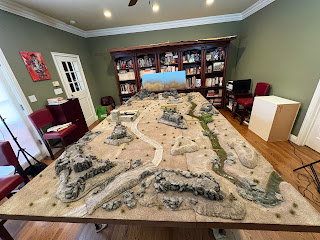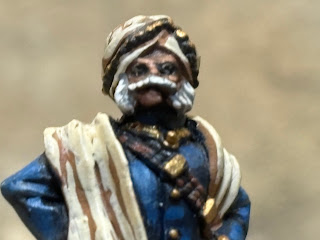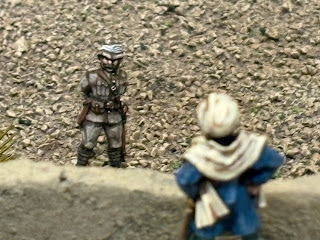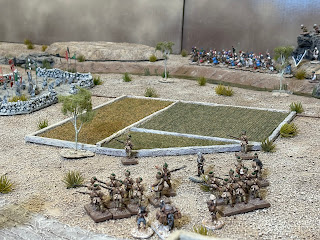Good News & Bad news: the Bad News is -- aside from the brief Castagnaro game report I put up a couple days ago -- it's been FAR TOO LONG since I've posted here, but the Good News is I've actually been fairly busy on the hobby front and my over-long delay in sharing is over...
Earlier this year I discovered a Second Afghan War battle, albeit of relatively small size, which I had not known existed. This may not sound like a big deal but with me being a life-long aficionado of that war, which lasted only three years, it kinda blew my mind -- in a good way, since it created a new horizon to explore and recreate on the tabletop.
The battle pitted 2 companies of Indian troops under the overall command of one British officer against somewhere between 1,200 and 1,500 Mohmand tribesmen. Over the course of the action 37 men arrived as reinforcements for the British side, but that still left them with less than 200 vs. more than a thousand of the enemy.
In addition to refighting the historical battle, I incorporated elements of the "Never Trust Anyone on the Frontier!" campaign game, which I've been participating in since it started 4 years ago, over on LAF aka: the Lead Adventure Forum.
The specific "elements" I wove into the game are the 2 central antagonists of the campaign: rival tribal leaders Mulehead Khan of the Waziris (My cursed foe!) and Umra Khan of the Afridis (My blessed friend!).
Artist's rendering of these two legends of the Frontier as youths:
The campaign takes place in the 1890s, so -- as with their participation last Summer in the Second Battle of Ali Masjid -- the part they play in this story sheds light on the days of their youth, before each became something of a "legend" on our campaign's version of the North-West Frontier.
Aside from the inclusion of Mulehead and Umra, the terrain and forces involved follow their historical precedents as closely as possible. For anyone interested in learning more about the real 1879 battle, here's a link to its Wikipedia page, which gives a brief but accurate summary:
https://en.wikipedia.org/wiki/Battle_of_Kam_Dakka
...and for those in search of more info, here's a link to Page 72 of "The Second Afghan War, Official Account" where the story of the battle is told through Page 76 in greater detail:
https://archive.org/details/in.ernet.dli.2015.282349/page/n79/mode/2up
-- or if you want the greatest detail possible, here's a link to "Vol. I Part 1, Frontier and Overseas Expeditions From India (Tribes North of the Kabul River)" where the section covering he battle runs from the top of Page 450 to the top of Page 459 going by the page-numbers seen in the printed text, and from p.494 to p.502 going by the overall page-count, including lettered preface pages, shown at the bottom of the web-page:
https://archive.org/details/in.ernet.dli.2015.23789/page/n493/mode/2up
Now here begins the story of the battle as it first unfolded, both in history and on my table. We'll start with some views of Kam Dakka & its environs...
View from the South:

View from the North:
View from the West:
View from the East...
From overhead:
In April 1879, during the lull that followed the first phase of the Second Afghan War, the village of Kam Dakka, located near the South bank of the Kabul River, 7 miles East of the recently occupied British fort at Dakka and 14 miles West of Landi Kotal -- the border town which marked the far Western edge of British India at the top of the strategically vital Khyber Pass -- requested support from the British to help them resist what they believed would be a coming large-scale raid by Mohmand tribesmen gathering on the North side of the river.
In addition to the village whose name it bore, the Kam Dakka Valley was also home to a cemetery and small collection of crop-fields, all of which, together with the village, were close to the Landi Kotal-to-Dakka road...
In response to the request for aid against the Mohmands, a reconnoitering force consisting of 1 squadron 10th Bengal Lancers, 3 companies Mhairwara Battalion (one of the Anglo-Indian Army's "Local Corps," recruited from the Mer people of Gujarat & Rajasthan), and 2 Royal Artillery guns was dispatched from Dakka Fort, but when they reached the village they found no sign of enemy activity. The residents however were adamant that very large numbers of Mohmands were gathering across the river and begged for the force to remain to help defend them, but with no sign of trouble visible, Major O. Barnes, the commander of Dakka fort who had personally led the reconnoitering force, chose to withdraw back to Dakka, rather than leave the garrison there shorthanded for an extended time.
However, after informing 2nd Division commander, Lt. General Maude at Landi Kotal via telegraph of the intelligence he had received from the residents of Kam Dakka, General Maude -- on the advice of his resident Political Officer, Major E.R. Conolly -- instructed Major Barnes to despatch 2 companies of Indian Inf. BACK to Kam Dakka at once, with the aim of supporting the friendly villagers there when and if they found themselves under attack.
So, on 21st of April, 1879, at five o'clock in the evening, 130 men of the Mhairwara Battalion under the command of Captain O'Moore Creagh, taking with them entrenching tools, spare ammunition and rations, left Dakka Fort for the 7 mile trek East to Kam Dakka...
Photos of the Mhairwara Battalion:
Unbeknownst to Capt. Creagh and his men, that same night someone else set out for the very same village -- albeit, from not so far away. I speak of the legendary future Afridi chieftain, Umra Khan. At this early date he was still but a young warrior, yet many already saw him as being marked for greatness, of one sort or another.
What was it that brought young Umra to journey West from his Afridi home on a visit to Kam Dakka? It's true that from the moment the Ferengi Infidel army took the fort at Ali Masjid and crossed the Khyber the year before, Umra had dreamt of doing battle with them, but... the opportunity to do so had not arrived, and when he left home for Kam Dakka he had no knowledge of the fact that Capt. Creagh and his men were simultaneously heading to the same destination, albeit from further away...


No, it was not bloodlust or dreams of glory that set Umra on the road to Kam Dakka, but something else entirely...





Not a sheep or a goat or a comely youth, but a woman both beautiful and modest, stubborn and god-fearing, kindly and ferocious. In short, a lapis lazuli of the frontier -- though rather than blue, she always dressed in black. And so, for our purposes, we shall call her henceforth Lajwardina -- "the Lapis-hued one"...

Meanwhile life in the rest of Kam Dakka valley went on as usual...
.jpeg)
.jpeg)







Until, after most of the day had passed, the village Headman, Malak Zan, spied something very unusual indeed approaching from the West...
Capt. Creagh and his men were arriving through Kam Dakka Pass...
Creagh's scouts reported no sign of hostile forces, but he still instructed and his men to keep their eyes peeled as they continued towards the village...
Once there, Creigh knocked on the locked front gate and spoke with the Headman, Malak Zan...
...and was quite astonished when the old fellow told him he would not let him in!
"But we're only here because you asked for us to come!" Creagh pointed out to him.
Malak Zan agreed that yes, it was true, he had requested their help, but... since the British in all their wisdom chose to send just a handful of men and no Tota Tota Top (“the piece-by-piece gun” AKA: SCREW-GUN) he and his fellow elders had decided they'ed be better off keeping the gates to their village shut to their would-be British benefactors.
Malak Zan assured Capt. Creagh that when the vast horde of Mohmands on the Jihad warpath arrived in the near-future, he and his village would not left a finger to support their attack on the English and their idol-worshipping lackeys. But of course... considering how many Mohmands they'd heard were coming, they wouldn't have to.
Despite the dilemma he now found himself in, Creagh did his best to keep calm and carry on. It was almost nightfall, so he posted piquets and had his men bivouac near the village. After all, his orders still were to, "help defend it against attack"...


And night fell over Kam Dakka...
Meanwhile, hunkered down in a dark corner of Kam Dakka, young Umra now faced his own dilemma: slip away in the night and make for home...
or stay and enjoy more of the hospitality of his host, while possibly getting a chance at that other kind of action...
...to wit, COMBAT -- whether against the hated Ferengi, or... against the Mohmands, who, despite being geographically close cousins, were no true friends of he and his fellow Afridis, or... by staying hunkered down until the newly-arrived pesky handful of Infidels had been dealt with by the Mohmands and then helping them to take the village of Kam Dakka from the inside?!?! Who could say what fantastic bounties they would bestow upon an ally who helped deliver such a prize into their hands? At this point the only thing Umra was sure of was that he had a lot to think about that...
Next morning at the crack of dawn, Captain Creagh knocked on the front gate of Kam Dakka again...
Old Malak Zan repeated his reply: thanks but no thanks. We are all good in here.
Suddenly the piquet to the North reported to Creagh: "Mohmands, sir! Thousands of 'em!"
Creagh had a look and replied: "Not thousands, Havildar. But quite a few hundred at least."
And who my children was there among that horde of Mohmands, if not that future master of ignominious Evil -- Mulehead Khan! Having somehow already found a way to get his still youngish Waziri self elevated to a leadership position amongst the Mohmands, albeit only leading one of the 6 clans now suddenly visible on the North side of the Kabul river...
Captain Creagh's first reaction was to send a fleet-footed sepoy to inform Dakka Fort that his detachment would soon be under attack by hundreds -- perhaps a thousand or more -- Mohmands, and urgently request reinforcements...
Next, Creagh surveyed his surroundings...
...and started maneuvering his men towards the one piece of terrain he believed could provide a chance for successful defense against overwhelming numbers: the cemetery located between the river and the road...
The sound of jezail fire rang out from across the river. Luckily for Creagh and the Mhairwaras they were out of range, but for how long who could say........
As they marched into for the coming maelstrom, neither Creagh nor Mulehead knew...
The eyes of Umra were upon them...
TO BE CONTINUED...



























.jpeg)
.jpeg)
































































Outstanding!
ReplyDeleteExcellent start to another great story.
ReplyDeleteAs only you can tell it.
Look forward to Part Two.